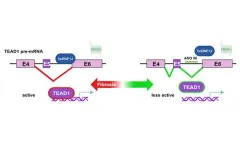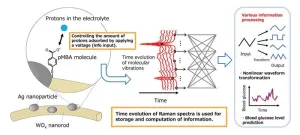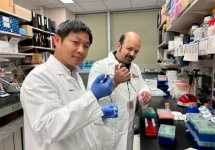(Press-News.org) In the last several decades, large forest fires have increasingly threatened communities across the Mediterranean. Climate change is expected to make these fires larger, hotter, and more dangerous in the future. But fire management lessons from the past could help to improve the resilience of local landscapes.
The latest research paper from environmental anthropologist and University of California, Santa Cruz Professor Andrew Mathews explores these issues in the Monte Pisano region of Central Italy. In particular, Mathews found that peasant women, who historically collected leaf litter in the forests, and shepherds, who grazed their flocks and conducted occasional managed burns, were critical in maintaining fire-resistant landscapes. Yet the social status of these groups meant the importance of their work went unrecognized.
In Monte Pisano and much of the broader Mediterranean, forests and other plant communities have been shaped by thousands of years of intensive human management of the land. But migration to cities since the 1960s has left rural lands increasingly abandoned. And without people to maintain them, local forests have become overgrown with highly flammable brush.
At the same time, many traditional rural land management practices that may have once reduced fire risk in the region have been systematically ignored and even criminalized over the years, to the point where they have been all but forgotten.
Luckily, though, there are a few people who still remember. Mathews and his research team sought out elderly people who were born between 1928 and 1956 in the Monte Pisano region and conducted oral history interviews to learn about traditional land management practices. In particular, the researchers asked about activities like collecting leaf litter, livestock grazing, and managed burning, which historical records suggested may have once been common.
“The people we interviewed were actually kind of excited to tell us these stories,” Mathews said. “Most people don't really ask them detailed questions about their daily lives from when they were younger, so they enjoyed retelling the stories, and they were such brilliant, thoughtful, interesting people. They were a lot of fun to talk to.”
Research participants described how forests were once full of human activity. Leaves were raked for use as stable bedding and fertilizer for olive groves. Logs and brush were collected for firewood and kindling. People gathered herbs, berries, and mushrooms in the forest, and sheep ate the grasses. Every scrap of wood or vegetation had a use, so the forest floor was almost bare in some places, and forests had an open, park-like appearance.
Meanwhile, in nearby pastures and olive groves, the buildup of grasses, brush, and brambles was kept under control through a combination of livestock grazing, manual brush cutting, and occasional managed burning. And whenever a wildfire sprang up in the forest, someone was always nearby to quickly extinguish it.
These historical accounts of the landscape were “an extraordinary difference” from what Matthews observed during forest transect walks in Monte Pisano in 2014. He and a botanist assistant recorded dense scrub and thick leaf litter, plus abundant fallen branches and brush that could easily act as “ladder fuels,” enabling flames to spread from the forest floor to the treetops.
Mathews wanted to estimate how much of this difference between modern and historical landscapes could reasonably be attributed to past land management practices. Since sheep were central to many of those practices—like leaf litter raking for stable bedding and grazing herds of sheep in forests—he started by comparing accounts from his oral history interviews with historical agricultural records to estimate the historical number of sheep per hectare of land in the region.
A prior study had modeled historical biomass removal in the Valais region of Switzerland for similar activities and a roughly comparable sheep-to-land ratio. So, based on the lowest estimates from that prior research, Mathews calculated that leaf litter raking alone could have historically extracted about 30-40% of the vegetation produced annually within the forest, with additional vegetation removal resulting from grazing, firewood collecting, and other activities.
These effects would have dramatically altered the landscape, leaving very little fuel for forest fires. Yet Mathews found that most people in the region today have very little awareness of these traditional land management practices that historically reduced fire risk. The research team interviewed local residents, firefighters, and government officials and observed community events to see what people understood about the history of local fire management.
“There was almost a complete disconnect,” Mathews said. “People have a general idea that landscape abandonment is a problem, but most have no idea that there was a history of controlled burning and care that made the landscape less flammable.”
The causes of this collective forgetting are rooted in historical politics of classism and sexism, Mathews’ research suggests.
Leaf litter raking and other land management activities were conducted by peasants, and oral history interviews further showed that it was typically women and children who did this work. The state considered peasant practices to be backwards and outdated amidst a push for agricultural modernization. And forestry policies that focused heavily on timber production led to the banning and stigmatization of traditional managed burning.
“Leaf litter raking was disregarded by the state because no one was earning money from it, and it was ‘women’s work’ being done by ‘unimportant’ people,” Matthews explained. “Similarly, shepherds, who were often the ones doing managed burning, have a long history of being stereotyped and regarded with suspicion across the Mediterranean. So the government never understood what they were doing or thought it was helpful.”
Mathews believes that communities around the world can learn from Monte Pisano’s traditional fire management practices, as well as from the consequences of forgetting them. He says that landscape abandonment similar to what took place in Italy in the mid- to late- 20th Century is currently happening in parts of Africa and South America. With that, there’s been a decrease in traditional managed burning on a global scale.
“We tend to think of fire as increasing around the world due to climate change, but at the same time, these traditional types of smaller, controlled fires are actually decreasing,” he said. “We should think hard about the impacts of eliminating agropastoral burning, because, in the end, it's likely to come back and bite us in the form of much larger fires.”
END
Anthropologist documents how women and shepherds historically reduced wildfire risk in Central Italy
2024-04-26
ELSE PRESS RELEASES FROM THIS DATE:
Living at higher altitudes in India linked to increased risk of childhood stunting
2024-04-26
Living at higher altitudes in India is linked to an increased risk of stunted growth, with children living in homes 2000 metres or more above sea level 40% more at risk than those living 1000 metres below, finds research published in the open access journal BMJ Nutrition Prevention & Health.
Children living in rural areas seem to be the most vulnerable, prompting the researchers to advocate prioritising nutritional programmes in hilly and mountainous regions of the country.
Despite ...
Scientists discover a new signaling pathway and design a novel drug for liver fibrosis
2024-04-26
A healthy liver filters all the blood in your body, breaks down toxins and digests fats. It produces collagen to repair damaged cells when the liver is injured. However, a liver can produce too much collagen when an excess accumulation of fat causes chronic inflammation, a condition called metabolic dysfunction-associated steatohepatitis (MASH). In an advanced state, MASH can lead to cirrhosis, liver cancer and liver-related death.
The cells that produce collagen in livers are called hepatic stellate cells (HSC). In a new paper published in Cell ...
High-precision blood glucose level prediction achieved by few-molecule reservoir computing
2024-04-26
1. A collaborative research team from NIMS and Tokyo University of Science has successfully developed a cutting-edge artificial intelligence (AI) device that executes brain-like information processing through few-molecule reservoir computing. This innovation utilizes the molecular vibrations of a select number of organic molecules. By applying this device for the blood glucose level prediction in patients with diabetes, it has significantly outperformed existing AI devices in terms of prediction accuracy.
2. With the expansion of machine learning applications in various industries, there's an escalating demand for AI devices that are not only highly ...
The importance of communicating to the public during a pandemic, and the personal risk it can lead to
2024-04-26
**ECCMID has now changed its name to ESCMID Global, please credit ESCMID Global Congress (formerly ECCMID, Barcelona, Spain, 27-30 April) in all future stories**
In global crises like the COVID-19 pandemic, it is vital that scientists step forward to engage with the public and help deliver medical and scientific advice in a friendly, digestible and open format. While the traditional way for scientists to do this is by responding to media requests, alternatives, including collaborating with illustrators and local communities, will be discussed in a new ...
Improving health communication to save lives during epidemics
2024-04-26
During epidemics of Ebola, COVID-19, Zika and other public health emergencies, effective communication of public health messages is crucial to control the spread of disease, maintain public trust, and encourage compliance with health measures. In a new evidence review to be given at this year’s ESCMID Global Congress (formerly ECCMID) in Barcelona, Spain (27-30 April), Dr Benjamin Djoudalbaye from the Africa Centres for Disease Control and Prevention (AFRICA CDC) in Ethiopia, will discuss the challenges and lessons learnt from public health communication strategies during multiple epidemics across ...
Antimicrobial-resistant hospital infections remain at least 12% above pre-pandemic levels, major US study finds
2024-04-26
Hospital-related infections resistant to carbapenems, considered the antibiotics of last resort for treating severe infections, remain at least 35% higher than before the pandemic.
Findings also reveal that during the pandemic, hospitals experiencing surges due to high volumes of severely ill COVID-19 patients had the greatest increases in hospital-acquired antimicrobial-resistant infections, as did larger hospitals with increased bed capacity.
**ECCMID has now changed its name to ESCMID Global, please credit ...
German study finds antibiotic use in patients hospitalised with COVID-19 appears to have no beneficial effect on clinical outcomes
2024-04-26
Findings underscore need for rational antibiotic use especially during viral pandemics like COVID-19.
*ECCMID has now changed its name to ESCMID Global, please credit ESCMID Global Congress (formerly ECCMID, Barcelona, Spain, 27-30 April) in all future stories**
Antibiotic treatment of adults hospitalised with moderate COVID-19 is associated with clinical deterioration, despite the drugs being given to over 40% of patients, according to new research being presented at this year’s ESCMID Global Congress (formerly ECCMID) in Barcelona, Spain (27-30 April)
The findings underscore the need to discourage indiscriminate prescribing ...
Targeting specific protein regions offers a new treatment approach in medulloblastoma
2024-04-25
Targeting specific protein regions offers a new treatment approach in medulloblastoma
Scientists at St. Jude Children’s Research Hospital discovered a new compound that selectively targets parts of a cancer-related protein, EP300/CBP, in Group 3 medulloblastoma.
(MEMPHIS, Tenn. – April 25, 2024) Medulloblastoma (the most common malignant childhood brain tumor) is separated into four molecular groups, with Group 3 bearing the worst prognosis. By studying EP300 and CBP, critical proteins in Group 3 medulloblastoma cells, scientists at St. Jude Children’s Research Hospital designed a way to enhance anti-tumor ...
$2.7 million grant to explore hypoxia’s impact on blood stem cells
2024-04-25
INDIANAPOLIS — Indiana University School of Medicine scientists are on a mission to understand why hematopoietic stem cells, responsible for producing all types of mature blood cells, exhibit better responses in a low-oxygen environment within the bone marrow, also known as hypoxia. Their discoveries and innovative approaches could influence treatment options like bone marrow transplantation for conditions such as bone marrow failure and rare blood diseases involving gene corrected stem cells.
A new four-year, ...
Cardiovascular societies propel plans forward for a new American Board of Cardiovascular Medicine
2024-04-25
CV Societies Propel Plans Forward for a New American Board of Cardiovascular Medicine
Planning enters next phase as ABMS announces open comment period
WASHINGTON (April 25, 2024) – Efforts by the American College of Cardiology, American Heart Association, Heart Failure Society of America, Heart Rhythm Society and The Society for Cardiovascular Angiography & Interventions to create a new, independent American Board of Cardiovascular Medicine under the American Board of Medical Specialties (ABMS) are closer to becoming a reality with the creation of a formal Board of Directors and the announcement by the ABMS Advisory Board on Specialty Board Development of an open comment ...



